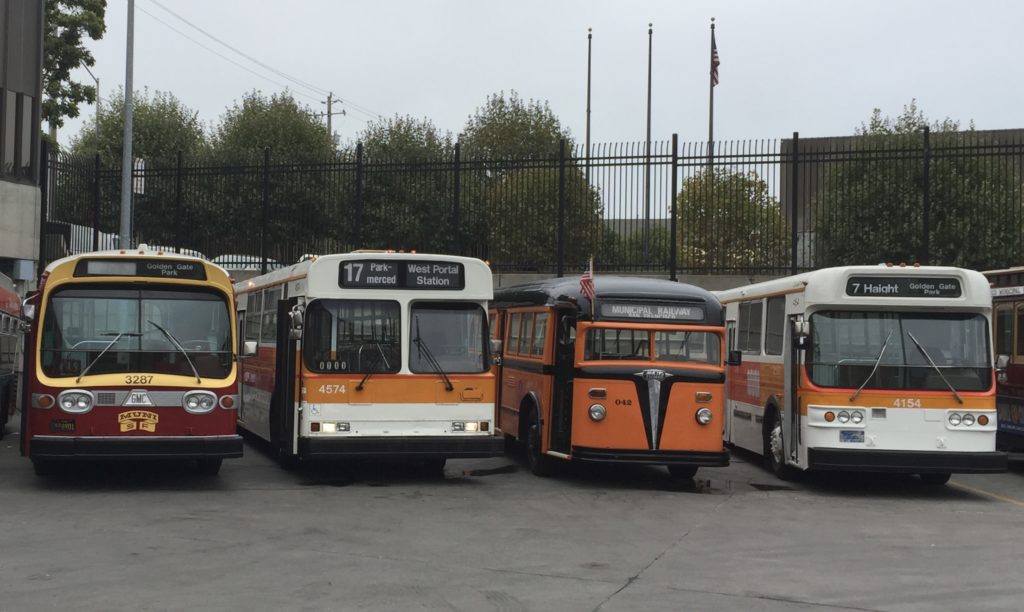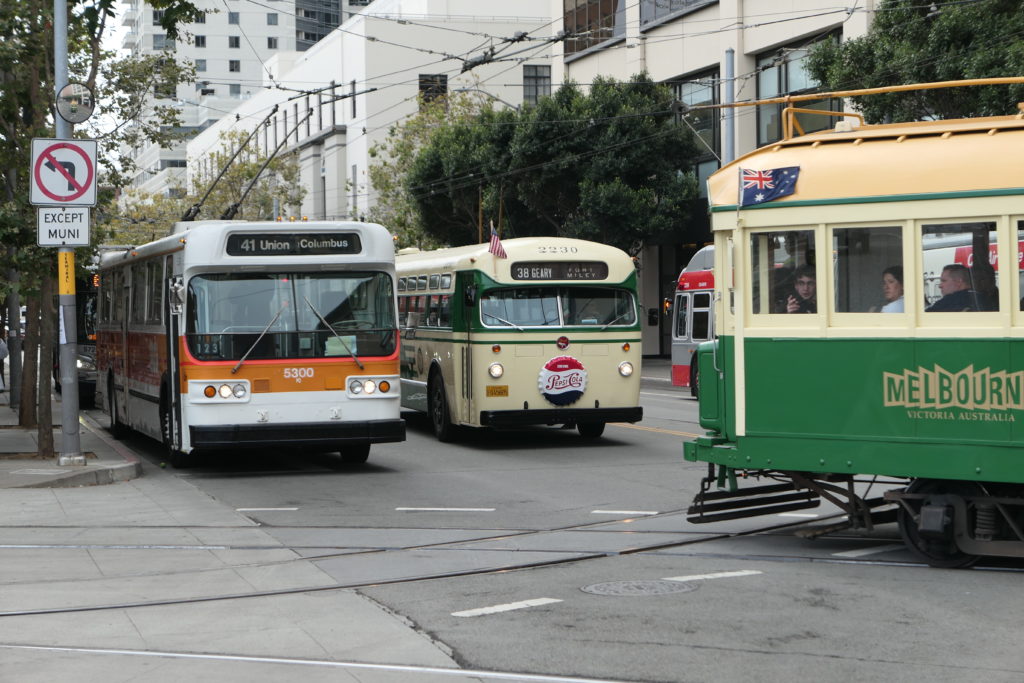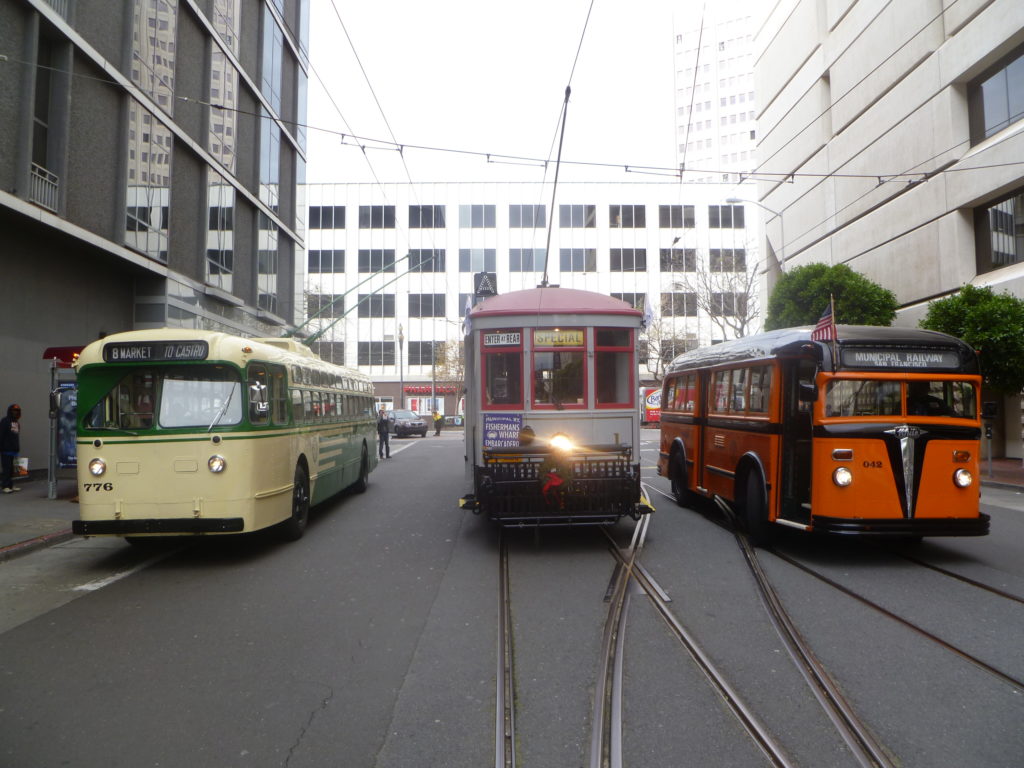Our nonprofit started up in 1977 to preserve a Muni trolley bus. Buses are a very important part of San Francisco transit history, too, and we now have a section of our website devoted to them, including an overview of bus history in the city, and profiles of the most historic buses in Muni’s vintage fleet (several of which we reacquired for Muni). Check it out!

Of course, we’re best known for our work in bringing back historic streetcars to our City, as well as our support for the iconic cable cars. But we love to see the looks on people’s faces when a vintage Muni bus, perfectly restored by the expert Muni maintenance team, makes an appearance on the street, as several will again this June 4 from 10-4, for Muni Heritage Day.


The trolley buses (trackless trolleys to us Easterners), I’m interested in. They come in second as the streetcars are first. Motor buses, nah, not at all.
Oh I give old 042 AKA as old 062 a pass…I’ve ridden that one often on the 39 Coit Tower line…last time was 1968…that old ‘White’ has character you don’t see in any other busses…Bob Lannon, Gridley CA
“That’s interesting John.
In the UK in my grandparents’ day, trolleybuses where called “trackless trams”
They are all great, BUT, give me a Marmon-Herrington Trolley Coach any day!
SF, what a wonderful, beautiful city for all of the United States, esp. for us electric transit fans.
Pray it comes back to reality!
BW
Long time waited for vintage rubber tired fleet to receive their day in the sun as well. Happy to see this new section added to the Market Street Railway website. Long overdue. Thank you.
Great added feature. Thanks
When I made my first serious visit to MuniLand in 1967, there were a few Whites still running, but most of the motor bus routes were covered by Macks. It’s strange to think of buses being nostalgic, but I would like to hear one of those Mack 673 engines again.
Like the streetcars always first. I also like all the trolley Coaches. I would hate to see them converted to motor coach lines,
The No. 776 is a classic Marmon. I liked them. Good looking both inside and outside.,.
You have assembled a remarkable cross section of motor coach transportation in San Francisco. One item however item is sorely
missing., That is the, Twin Coach, (I believe it might be a model 37 or 40R) from Seattle, painted in the circa 1939 Market Street Ry. Co, .livery. With the addition of that coach your collection will be complete.
Our section contains only those San Francisco vintage buses that operated here and are at least 40 years old. The Seattle coach was one of several Muni acquired in the late 1980s but lost interest in after the one you mentioned (renumbered Coach 50 in MSRy colors) operated one time. It’s still on Muni property, but inoperable, and I don’t believe they have any plans to restore it. They’ve got a full plate of their own vintage buses first, including some more recent ones we haven’t yet created pages for.
….I remember riding the trackless trolleys in Milwaukee in the 1950s and 60s. We had a number of routes most of which had previously been streetcar lines. The city;s system (then privately privately operated) had both Marmons and Pullmans in their fleet. All the seats were leather and nicely padded compared to seats today, and they were so smooth ad quiet riding (as well as less smelly) than to the Faelgol Twin Coaches and TDH 5105’s. The last ones to operate were on the #18 line (which was the one that we used to rid every year to the Fair Park for the fair) and service was ceased after June 19th, 1965. I took a ride to the end of the line and back on that final day of operation. By then the “Fishbowls” were becoming more and more common replacing older GMs and Faegol (which were retired a year later.) on major routes including the Fair Park line.
Chicago’s CTA still had few lines operating until 1973.using AM Generals.
I am very surprised at the Trolley Coach Systems in place are converting to electric busses. Not thinking long term and costs.
In San Francisco, it is nowhere near a final decision and in the best case would be 20 or years away, and that’s IF the test battery buses they just had delivered prove they can operate in a sustained, cost-effective way on the city’s steepest routes. Battery packs for buses cost more than $100K apiece, and their lifespan in daily use hasn’t yet been determined. Best guess: San Francisco retains trolley buses for decades to come on at least the 1, 22, 24, 33 and 41/45 lines, and maybe the 30, all of which could be run out of Presidio Division, converting Potrero (about to be rebuilt) for battery buses. But only a guess.
In Boston, we sadly are moving into this direction. We just took a final farewell tour this weekend for our trackless trolleys. I am skeptical that the technology is ready, but the MBTA seems to think it will be in two years when the lines open back up after construction.
Thanks Rick! I always enjoy reading on anything MUNI.